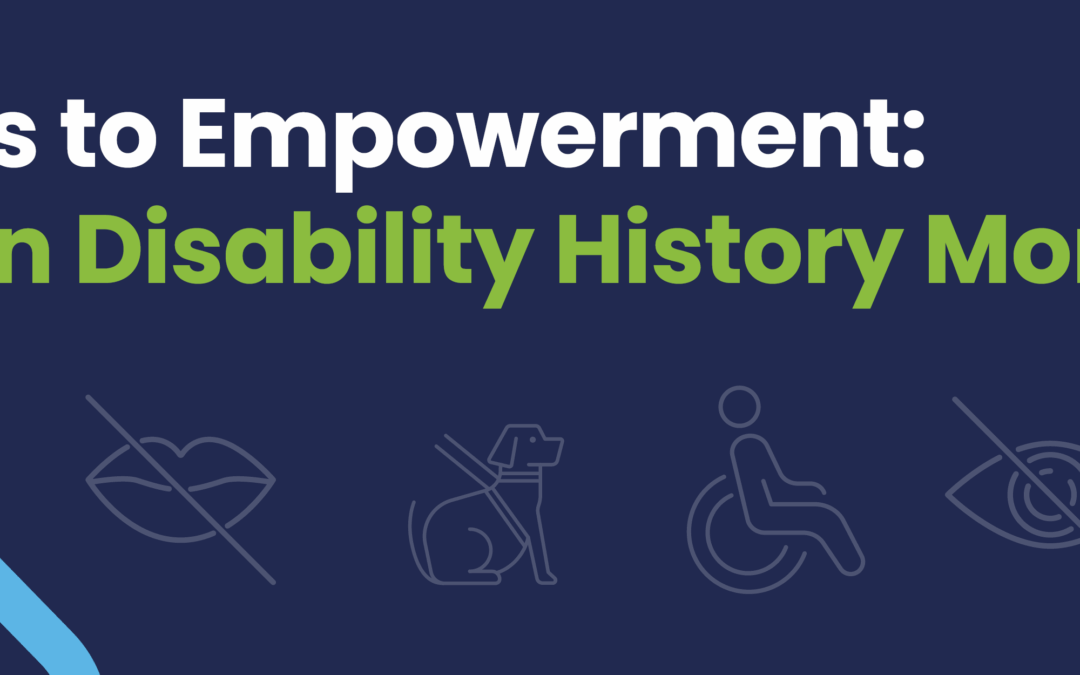From Access to Empowerment:
Reflecting on Disability History Month
Disability History Month isn’t just a time to look back – it’s an opportunity to reflect on how far we’ve come, and how much further we still need to go. While physical accessibility has been on the agenda for decades, true inclusion goes deeper. It’s about how we communicate, design, and deliver – especially when it comes to learning.
From the early days of the Disability Discrimination Act to the Equality Act 2010 and beyond, every step forward in disability rights has reshaped how organisations think about accessibility. No longer limited to ramps and accessible toilets, the conversation now includes digital spaces, learning platforms, and everyday communication – the tools that enable participation in a modern workplace.
This blog explores how the history of disability inclusion has influenced modern learning design, and why accessibility in training isn’t an optional extra – it’s the foundation for effective, equitable learning.

A Brief Timeline of Disability Rights in the UK
The Disability Discrimination Act 1995
The Disability Discrimination Act 1995 (DDA) was a turning point. For the first time, it became unlawful to discriminate against disabled people in employment, education, and access to goods and services. It began to shift mindsets – from viewing disability through a medical lens (“What’s ‘wrong’ with the person?”) to a social model (“What barriers are preventing participation?”).
The Equality Act 2010
The Equality Act 2010 built on the DDA, uniting various anti-discrimination laws under one framework. Crucially, it placed a proactive duty on employers and service providers to make “reasonable adjustments” – not just to respond when asked, but to anticipate and remove barriers before they arise.
Growing awareness of hidden disabilities and neurodiversity
In recent years, awareness has expanded beyond visible disabilities. Conditions like dyslexia, ADHD, autism, chronic pain, and mental health challenges are now recognised as part of the disability spectrum. This has prompted a broader, more nuanced understanding of accessibility – one that considers cognitive load, sensory processing, and emotional wellbeing.
The role of campaigners and lived experience
Progress has always been driven by the voices of disabled people themselves – campaigners, educators, and individuals sharing their lived experiences. Their advocacy has not only shaped law, but has transformed public understanding of what inclusion looks like in practice.

What This Means for Learning and Development
For many years, accessibility in learning was treated as a box-ticking exercise – a few alternative formats here, some captioning there. But genuine inclusion goes further. It’s about ensuring every learner can engage meaningfully with training, regardless of their circumstances.
Legal compliance vs meaningful inclusion
Meeting legal requirements is the starting point, not the finish line. True accessibility means asking:
- Can everyone participate fully in this learning experience?
- Does our content assume certain physical, sensory, or cognitive abilities?
- Are we designing for variety – or for the ‘default’ learner?
Unintended exclusion
When training isn’t designed inclusively, learners can be excluded in subtle but significant ways. Fast-paced videos without transcripts, confusing navigation, or poor contrast can create barriers that stop people engaging altogether. And when someone can’t access learning, they can’t access opportunity.

The Digital Accessibility Checklist (And Why It’s Just the Start)
Digital accessibility starts with good design – but good design starts with empathy.
Key accessibility basics include:
- Captions, alt-text, and transcripts for all media
- Keyboard navigation for users who don’t use a mouse
- Clear contrast and colour choices for readability
- Simple, consistent layouts that support screen readers
- User experience (UX) design for neurodivergent learners (e.g. predictable navigation, optional animation)
- Inclusive character design, ensuring visuals (like our eByte monsters) are neutral in terms of age, race and gender, so that all learners can see themselves reflected
But these are the minimum standards. Accessibility isn’t just about compliance – it’s about designing experiences that respect and empower every learner.

Moving Beyond Access: Designing for Empowerment
Once barriers are removed, inclusion can evolve into empowerment. That means designing learning that not only includes disabled people, but reflects and values their experiences.
Representation in learning
Learners notice when examples, scenarios, or characters don’t reflect their reality. Representation matters – in imagery, case studies, and voices. Including diverse, lived experiences helps to normalise difference and challenge bias.
Designing for application, not just access
Accessible design should go beyond allowing people to consume learning – it should help them to apply it. Tools like adjustable text size, alternative learning paths, and self-paced modules can help to make learning not just available, but effective.
When learners feel seen and supported, that’s when accessibility transforms from a compliance goal into a cultural one.

Our Commitment
At Learning Nexus, we’re on a journey – and like most journeys, it’s one of learning through doing.
We’re actively reviewing and redesigning our digital courses to make them more accessible. That includes adding full captions and transcripts, improving screen reader compatibility, and testing our learning interfaces for neurodiverse user experiences.
We’ve also learned from our own missteps – times when our design choices didn’t work for everyone, or when accessibility came too late in the process. Those lessons are helping us to build better from the start.
Looking ahead, we’re developing new accessibility standards for all our course design and testing. Because for us, inclusion isn’t a project with an end date – it’s an ongoing commitment.
Disability History Month reminds us that inclusion didn’t start with law, and it doesn’t end with compliance. It’s about continual reflection and improvement, ensuring every learner can thrive.
Accessibility isn’t a bonus – it’s the baseline. And when we design learning that works for everyone, then everyone benefits.

